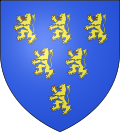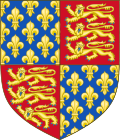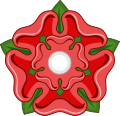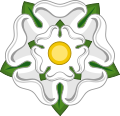- Henry III of England
-
Henry III 
Oil painting of Henry III by unknown artist, ca. 1620, later incorrectly inscribed "Eduardus". King of England (more...) Reign 18 October 1216 – 16 November 1272 Coronation 28 October 1216, Gloucester
17 May 1220, Westminster AbbeyPredecessor John Successor Edward I Regent William Marshal, 1st Earl of Pembroke (1216–18)
Hubert de Burgh, 1st Earl of Kent (1219–27)Consort Eleanor of Provence Issue Edward I of England
Margaret, Queen of Scots
Beatrice, Countess of Richmond
Edmund, 1st Earl of Leicester and LancasterHouse House of Plantagenet Father John, King of England Mother Isabella, Countess of Angoulême Born 1 October 1207
Winchester Castle, HampshireDied 16 November 1272 (aged 65)
Westminster, LondonBurial Westminster Abbey, London Henry III (1 October 1207 – 16 November 1272) was the son and successor of John as King of England, reigning for 56 years from 1216 until his death. His contemporaries knew him as Henry of Winchester. He was the first child king in England since the reign of Æthelred the Unready. England prospered during his reign and his greatest monument is Westminster, which he made the seat of his government and where he expanded the abbey as a shrine to Edward the Confessor. He is the first of only five monarchs to rule the Kingdom of England or its successor states for 50 years or more, the others being Edward III (1327–1377), George III (1760–1820), Queen Victoria (1837–1901) and Elizabeth II (1952–present).
He assumed the crown under the regency of the popular William Marshal, 1st Earl of Pembroke, but the England he inherited had undergone several drastic changes in the reign of his father. He spent much of his reign fighting the barons over Magna Carta[1][2][3][4] and the royal rights, and was eventually forced to call the first "parliament" in 1264. He was also unsuccessful on the Continent, where he endeavoured to re-establish English control over Normandy, Anjou, and Aquitaine.
Contents
Minority
Henry III was born in 1207 at Winchester Castle, the son of King John and Isabella of Angoulême. His coronation at age nine was a simple affair, attended by only a handful of noblemen and three bishops at St Peter's Abbey, Gloucester. In the absence of a crown (the crown had recently been lost with all the rest of his father's treasure in a wreck in East Anglia)[5] a simple golden band was placed on the young boy's head, not by the Archbishop of Canterbury (who was at this time supporting Prince Louis "the Lion", the future king of France) but by another clergyman—either Peter des Roches, Bishop of Winchester, or Cardinal Guala Bicchieri, the Papal legate. In 1220 a second coronation was ordered by Pope Honorius III who did not consider that the first had been carried out in accordance with church rites. This occurred on 17 May 1220 in Westminster Abbey.[6]
Under John's rule the barons had supported an invasion by Prince Louis because they disliked the way that John had ruled the country. However, they quickly saw that the young prince was a safer option. Henry's regents immediately declared their intention to rule by Magna Carta, which they proceeded to do during Henry's minority.
Eleanor of Brittany
The treatment of his elder cousin Eleanor of Brittany, who was 23 years his senior (and older than his mother), was a difficult problem for Henry.
Eleanor was the daughter of Duke Geoffrey II of Brittany, elder brother of King John, which meant that she had a better claim to the English throne than John and Henry according to Primogeniture, thus should have been queen regnant in 1203. But in 1202 John captured Eleanor at Mirebeau. When John died, the barons passed her over and crowned Henry, leaving the beautiful and defiant princess still imprisoned at Corfe Castle at Dorset, guarded by Peter de Maulay.
Viewing her claim to England and Aquitaine, though with little baronial support for her sex, as a threat, the regents, later Henry himself, viewed Eleanor as "state prisoner" and kept her in a state of semi-captivity,[7] or "under a gentle house arrest",[8] and never permitted her to marry. Before Henry held real power, it was alleged that there was a plot to spirit Eleanor away and deliver her to the king of France; de Maulay was accused of the plot and fell out of favor. However many believed such a plot was just an excuse aiming to discredit de Maulay and Peter des Roches, who would also fall out of favor in spring 1234. Shortly after the plot was discovered, Eleanor was moved away from coast and transferred between Gloucester, Marlborough and Bristol Castle.[9] To prevent her from liberation, the princess was under strict custody and always closely guarded, even after child-bearing years.[10] But on the other side, Henry also showed his generosity to his cousin. He styled Eleanor, who had been left no title, as "king's kinswoman" ,[9] referred her as "our cousin", and it was recorded that she lived as comfortably as a royal princess who received generous gifts from royal family.[7][11] Henry himself once gave Eleanor a saddle, suggesting that she was probably a horsewoman,[12] and was not always confined in her apartment. On another occasion, Henry sent her 50 yards of linen cloth, three wimples, 50 pounds of almonds and raisins respectively and a basket of figs.[13] In November 1237 at Woodstock, Henry met a healthy Eleanor. Then the princess was again taken captive to Gloucester under the custody of William Talbot, and the sheriff there paid for her expenses. In the final years of her life Eleanor was moved to Bristol, and Henry ordered the mayor and bailiff there to increase her household.[14] The governor there exhibited her to the public annually, in case there might be rumors that the royal captive had been injured. The fact might suggest that English people were sympathetic to her.[15]
On 10 August 1241 Eleanor died, and was buried at Amesbury. In the Chronicle of Lanercost there was a legend saying that before her death, the remorseful Henry gave her a gold crown, which would be donated to his young son Edward three days later. Another version of events stated that Eleanor returned the crown after wearing it for only one day.[7] After his cousin, who actually never gave up her rights and claim, finally died an unmarried prisoner, Henry was now indisputably the rightful king of England, although years later he was still unwilling to admit that Eleanor had preceded him in English succession line.[16]
In 1268 Henry donated a manor in Melksham, a place that Eleanor had shown her interest in, to Amesbury for the souls of Eleanor and her younger-brother Arthur, who was captured along with his sister and disappeared mysteriously the next year, it being widely believed that John had him murdered.[17][9][18]
Wars and rebellions
In 1244, when the Scots threatened to invade England, King Henry III visited York Castle and ordered it rebuilt in stone. The work commenced in 1245, and took some 20 to 25 years to complete. The builders crowned the existing moat with a stone keep, known as the King's Tower.
Henry's reign came to be marked by civil strife as the English barons, led by Simon de Montfort, demanded more say in the running of the kingdom. French-born de Montfort had originally been one of the King's foreign counselors—a group much resented by the barons. Henry, in an outburst of anger over de Monfort's behaviour in a financial matter, accused de Montfort of seducing his sister and forcing him to give her to de Montfort to avoid a scandal. When confronted by the Barons about the secret marriage that Henry had allowed to happen, a feud developed between the two. Their relationship reached a crisis in the 1250s when de Montfort was brought up on spurious charges for actions he had taken as lieutenant of Gascony, the last remaining Plantagenet land across the English Channel. He was acquitted by the Peers of the realm, much to the King's displeasure.
Henry also became embroiled in funding a war in Sicily on behalf of the Pope in return for a title for his second son Edmund. This situation led many of the barons to fear that Henry was following in his father's footsteps and therefore also needed to be kept in check. De Montfort became leader of those who wanted to reassert Magna Carta and force the king to surrender more power to the baronial council. In 1258 seven leading barons forced Henry to agree to the Provisions of Oxford, which effectively abolished the absolutist Anglo-Norman monarchy, giving power to a council of fifteen barons to deal with the business of government and providing for a thrice-yearly meeting of parliament to monitor their performance. Henry was forced to take part in the swearing of a collective oath to the Provisions of Oxford.
In the following years those supporting de Montfort and those supporting the king grew more and more polarised. Henry obtained a papal bull in 1262 exempting him from his oath and both sides began to raise armies. The Royalists were led by Prince Edward, Henry's eldest son. A civil war, known as the Second Barons' War, ensued.
 Engraving of a sealing of Henry III[19]
Engraving of a sealing of Henry III[19]
The charismatic de Montfort and his forces had captured most of southeastern England by 1263, and at the Battle of Lewes on 14 May 1264, Henry was defeated and taken prisoner by de Montfort's army. While Henry was reduced to being a figurehead king, de Montfort broadened representation to include each county of England and many important towns—that is, to groups beyond the nobility. Henry and Edward remained under house arrest. The short period that followed was the closest England was to come to complete abolition of the monarchy until the Commonwealth period of 1649–60 and many of the barons who had initially supported de Montfort began to suspect that he had gone too far with his reforming zeal.
Fifteen months later Prince Edward had escaped captivity (having been freed by his cousin Roger Mortimer) and led the royalists into battle, turning the tables on de Montfort at the Battle of Evesham in 1265. Following this victory, savage retribution was exacted on the rebels.
Though not seen as the most tyrannical of kings, unlike his son Prince Edward, discontent was common during Henry's time and, though traditionally thought of as belonging to the time of King John, the earliest Robin Hood sources and tales suggest that, if he existed at all, it was during Henry's reign.
Death
On Henry's death in 1272 he was succeeded by his son Edward I. His body was laid, temporarily, in the tomb of Edward the Confessor while his own sarcophagus was constructed in Westminster Abbey.
Attitudes and beliefs during his reign
As Henry reached maturity he was keen to restore royal authority, looking towards the autocratic model of the French monarchy.[citation needed] Henry married Eleanor of Provence and he promoted many of his French relatives to higher positions of power and wealth. For instance, one Poitevin, Peter de Rivaux, held the offices of Treasurer of the Household, Keeper of the King's Wardrobe, Lord Privy Seal, and the sheriffdoms of twenty-one English counties simultaneously. Henry's tendency to govern for long periods with no publicly-appointed ministers who could be held accountable for their actions and decisions did not make matters any easier. Many English barons came to see his method of governing as foreign.
Henry was much taken with the cult of the Anglo-Saxon saint king Edward the Confessor who had been canonised in 1161. After learning that St Edward dressed in an austere manner, Henry took to doing the same and wearing only the simplest of robes. He had a mural of the saint painted in his bedchamber for inspiration before and after sleep and even named his eldest son Edward. Henry designated Westminster, where St Edward had founded the abbey, as the fixed seat of power in England and Westminster Hall duly became the greatest ceremonial space of the kingdom, where the council of nobles also met. Henry appointed French architects from Rheims to renovate Westminster Abbey in the Gothic style. Work began, at great expense, in 1245. The centrepiece of Henry's renovated abbey was a shrine to Edward the Confessor. It was finished in 1269 and the saint's relics were then installed.
Henry was known for his anti-Jewish decrees, such as a decree compelling Jews to wear a special "badge of shame" in the form of the Two Tablets. He exacted several tallages specifically from Jews to raise money for his campaigns.
Henry was pious and his journeys were often delayed by his insistence on hearing Mass several times a day. He took so long to arrive for a visit to the French court that his brother-in-law, King Louis IX of France, banned priests from Henry's route. On one occasion, as related by Roger of Wendover, when King Henry met with papal prelates, he said, "If [the prelates] knew how much I, in my reverence of God, am afraid of them and how unwilling I am to offend them, they would trample on me as on an old and worn-out shoe."
Criticisms
Henry's advancement of foreign favourites, notably his wife's Savoyard uncles and his own Lusignan half-siblings, was unpopular with his subjects and barons. He was also extravagant and avaricious; when his first child, Prince Edward, was born, Henry demanded that Londoners bring him rich gifts to celebrate. He even sent back gifts that did not please him. Matthew Paris reports that some said, "God gave us this child, but the king sells him to us".
Appearance
According to Proulx et al., Henry was a thickset man of great stature who was often revered for his smooth skin. (His son, Edward I suffered from a droopy eyelid.)
Marriage and children
Married on 14 January 1236, Canterbury Cathedral, Canterbury, Kent, to Eleanor of Provence, with at least five children born:
- Edward I (b. 17 June 1239 – d. 7 July 1307)
- Margaret (b. 29 September 1240 – d. 26 February 1275), married King Alexander III of Scotland
- Beatrice of England (b. 25 June 1242 – d. 24 March 1275), married to John II, Duke of Brittany
- Edmund Crouchback (16 January 1245 – d. 5 June 1296)
- Katherine (b. 25 November 1253 – d. 3 May 1257), deaf and mute from birth,[20][21] though her deafness may not have been discovered until age 2.[22]
There is reason to doubt the existence of several attributed children of Henry and Eleanor.
- Richard (b. after 1247 – d. before 1256),
- John (b. after 1250 – d. before 1256), and
- Henry (b. after 1253 – d. young)
are known only from a 14th century addition made to a manuscript of Flores Historiarum, and are nowhere contemporaneously recorded.
- William (b. and d. ca. 1258) is an error for the nephew of Henry's half-brother, William de Valence, 1st Earl of Pembroke.
Another daughter, Matilda, is found only in the Hayles Abbey chronicle, alongside such other fictitious children as a son named William for King John, and an illegitimate son named John for King Edward I. Matilda's existence is doubtful, at best. For further details, see Margaret Howell, The Children of King Henry III and Eleanor of Provence (1992).
Personal details
- His Royal Motto was qui non dat quod habet non accipit ille quod optat (He who does not give what he has, does not receive what he wants).
- His favourite wine was made with the Loire Valley red wine grape Pineau d'Aunis which Henry first introduced to England in the thirteenth century.[23]
- He built a Royal Palace in the town of Cippenham, Slough, Berkshire named "Cippenham Moat".
- In 1266 Henry III of England granted the Lübeck and Hamburg Hansa a charter for operations in England, which contributed to the emergence of the Hanseatic League.
Fictional portrayals
- In The Divine Comedy, Dante sees Henry ("the king of simple life") sitting outside the gates of Purgatory with other contemporary European rulers.
- Henry is a prominent character in Sharon Kay Penman's historical novel Falls the Shadow; his portrayal is very close to most historical descriptions of him as weak and vacillating.
- Henry's Court is described in some detail in James Blish's historical novel concerning Roger Bacon, Doctor Mirabilis. Critical events of Henry's reign are well described, including the dismissal of Peter des Roches (after a politically loaded riddle by Roger Bacon is answered by Henry), the ejection of Poitevins from England, the conflict with Hubert de Burgh, the marriage of Eleanor with Simon de Montfort, and finally the accession of Henry's son, Edward I after the battle of Evesham. The imprisonment of Eleanor is lightly dealt with, and the story of her crown is turned to the advantage of Bacon, who is said to have received the crown as a gift to secure funding for the publishing of his last great book, Liber de retardatione, concerning old age and its amelioration though the sciences.
- Henry has been portrayed on screen only rarely. As a child he has been portrayed by Dora Senior in the 1899 silent short King John (1899), a version of John's death scene from Shakespeare's King John, and by Rusty Livingstone in the 1984 BBC Television Shakespeare version of the play.
Ancestors
Ancestors of Henry III of England 16. Fulk, King of Jerusalem 8. Geoffrey V, Count of Anjou 17. Ermengarde, Countess of Maine 4. Henry II of England 18. Henry I of England 9. Empress Matilda 19. Matilda of Scotland 2. John, King of England 20. William IX, Duke of Aquitaine 10. William X, Duke of Aquitaine 21. Philippa, Countess of Toulouse 5. Eleanor of Aquitaine 22. Aimery I, Viscount of Châtellerault 11. Aenor de Châtellerault 23. Dangereuse de L' Isle Bouchard 1. Henry III of England 24. Wulgrin II Taillifer, Count of Angoulême 12. William VI (Taillefer IV), Count of Angoulême 25. Panica de la Marche 6. Aymer Taillifer, Count of Angoulême 26. Raymond I, Viscount of Turenne 13. Marguerite de Turenne 27. Matilda de la Perche 3. Isabella of Angoulême 28. Louis VI of France 14. Peter of Courtenay 29. Adelaide of Maurienne 7. Alice of Courtenay 30. Reinald de Courtenay 15. Elizabeth de Courtenay 31. Hedwig du Donjon See also
- Fine rolls
- Henry de Bracton
- Statutes of Mortmain
References
- ^ Henry III, Treasures in full: Magna Carta, British Library
- ^ Henry III (r. 1216–1272), Official website of the British Monarchy
- ^ The Magna Carta and the creation of England's Parliament, HyperHistory.net
- ^ King Henry III biography, Medieval Life and Times
- ^ Given-Wilson, Chris (1996). An Illustrated History of Late Medieval England. Manchester University Press, Manchester. p. 87. ISBN 0-7190-4152-X.
- ^ "Henry III, Archonotology.org". http://www.archontology.org/nations/england/king_england/henry3.php. Retrieved 2007-12-10.
- ^ a b c A Bit of History WebSite
- ^ http://history-notes.co.uk/Kings%20and%20Queens/Henry%20III.html
- ^ a b c Plantagenet ancestry: a study in colonial and medieval families, by Douglas Richardson and Kimball G. Everingham
- ^ Feud, violence and practice: essays in medieval studies in honor of Stephen D. White by Belle S. Tuten, Tracey L. Billado, p.280-285
- ^ LIVES OF ENGLAND’S MONARCHS by H. Eugene Lehman
- ^ Eleanor of Brittany in captivity
- ^ Royal palaces: an account of the homes of British sovereigns from Saxon to modern times by Olwen Hedley
- ^ Bristol Castle:In a code of instructions signed at Berkeley, 28 August 1249, the King enjoins the mayor and bailiff of Bristol "to lengthen three windows of his chapel, and to whitewash it throughout; also glass windows are ordered to be put in our hall at Bristol, a royal seat in the same hall, and dormant tables around the same, and block up the doors of the chapel beside our great hall there, and make a door in the chancel towards the hermitage; in that hermitage make an altar to St. Edward, and in the turret over that hermitage make a chamber for the clerk with appurtenances; also build a kitchen and a sewer beside the said hall, and find the wages of a certain chaplain whom we have ordered to celebrate divine service in the chapel of our tower there all the days of our life, for Eleanor of Brittany, our cousin, to wit, 50s. per annum."
- ^ Chilcott's descriptive history of Bristol by John Chilcott
- ^ The compiler of the "revised Glanvill" of the Cambridge Library notices the casus Regis: Harvard Law Review, vi. 19.
- ^ Eleanor of Brittany and Her Treatment by King John and Henry III by G. Seabourne
- ^ British History Online
- ^ From Louis Blancard, Iconographie des sceaux et bulles, 1860
- ^ Katherine Plantagenet, daughter of Henry III, RoyaList Online
- ^ Swallowfield, David Nash Ford's Royal Berkshire History
- ^ FAQ: Earliest Known Deaf People, Gallaudet University
- ^ J. Robinson Vines Grapes & Wines pg 199 Mitchell Beazley 1986 ISBN 1-85732-999-6
External links
- Henry III of England at Genealogics
- Henry III in the World History Database
- Henry III of England, Foundation for Medieval Genealogy
- Henry III at Royal Family History
Henry III of EnglandBorn: 1 October 1207 Died: 16 November 1272Regnal titles Preceded by
John LacklandKing of England
Duke of Aquitaine
Lord of Ireland
1216–1272Succeeded by
Edward IEnglish monarchs Kingdom of the
English
886–1066- Alfred the Great
- Edward the Elder
- Ælfweard
- Athelstan the Glorious1
- Edmund the Magnificent1
- Eadred1
- Eadwig the Fair1
- Edgar the Peaceable1
- Edward the Martyr
- Æthelred the Unready
- Sweyn Forkbeard
- Edmund Ironside
- Cnut1
- Harold Harefoot
- Harthacnut
- Edward the Confessor
- Harold Godwinson
- Edgar the Ætheling
Kingdom of
England
1066–1649- William I
- William II
- Henry I
- Stephen
- Matilda
- Henry II2
- Henry the Young King
- Richard I
- John2
- Henry III2
- Edward I2
- Edward II2
- Edward III2
- Richard II2
- Henry IV2
- Henry V2
- Henry VI2
- Edward IV2
- Edward V2
- Richard III2
- Henry VII2
- Henry VIII2
- Edward VI2
- Jane2
- Mary I2 with Philip2
- Elizabeth I2
- James I3
- Charles I3
Commonwealth of
England, Scotland and Ireland
1653–1659Kingdom of
England
1660–1707- Charles II3
- James II3
- William III and Mary II3
- Anne3
1Overlord of Britain. 2Also ruler of Ireland. 3Also ruler of Scotland. 4Lord Protector.
Debatable or disputed rulers are in italics.Dukes of Normandy House of Normandy
911–1135Rollo · William I · Richard I · Richard II · Richard III · Robert I · William II · Robert II · Henry I · William IIIHouse of Blois
1135–1144House of Plantagenet
1144–1259Categories:- 1207 births
- 1272 deaths
- Burials at Westminster Abbey
- Dukes of Normandy
- English monarchs
- English people of French descent
- English people of Scottish descent
- House of Plantagenet
- People from Winchester
- Medieval child rulers
Wikimedia Foundation. 2010.









